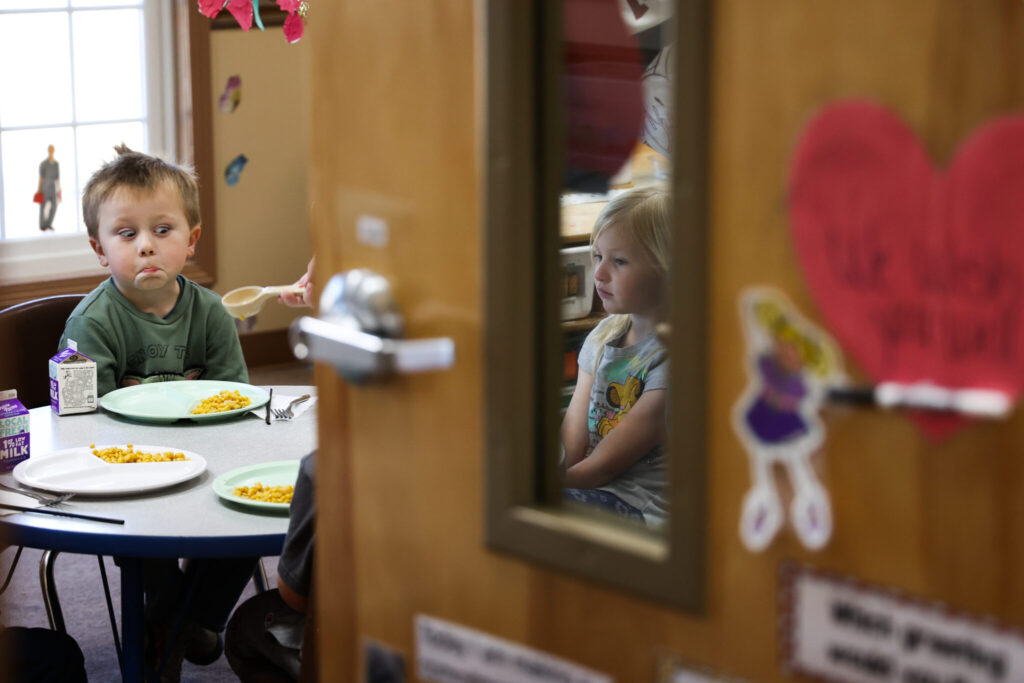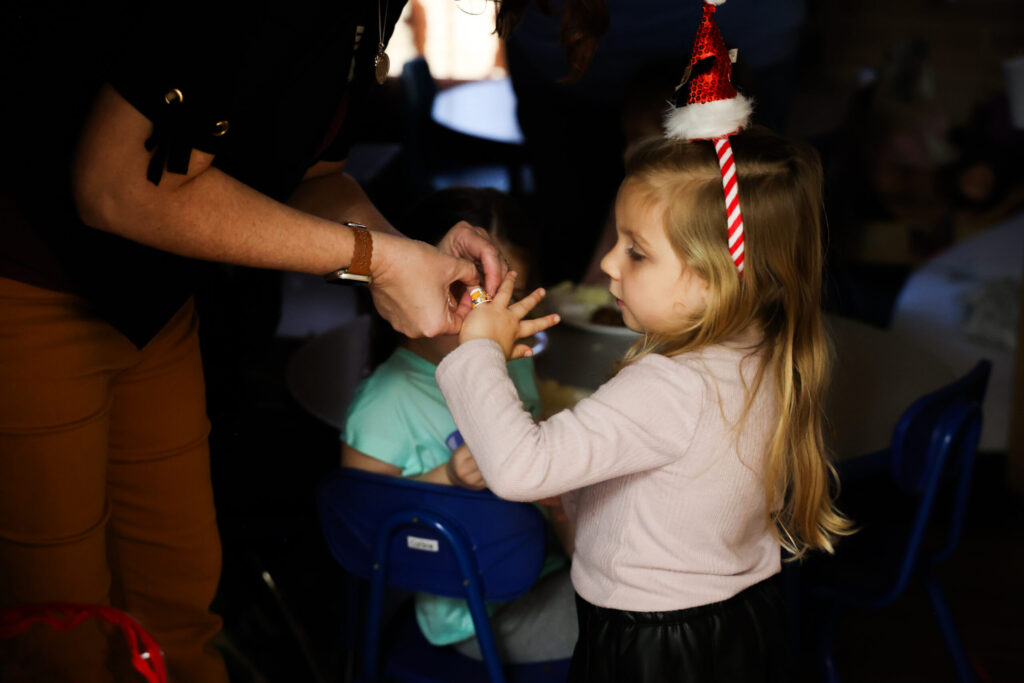BENTON — Children’s laughter wafts throughout the iKids Childhood Enrichment Center in this West Kentucky town, around midday.

Dozens of children, whom the center staff call “friends,” get their final bursts of energy out before the post-lunch nap. Then, they sprawl on their classroom cots and drift away to dream.
This is a vision of normality, of happy childhood. But beneath it all, iKids and many other child care centers and homes in Kentucky face a coming year riddled with uncertainty.
Without funding help from the state legislature to subsidize COVID-19 era federal assistance and stabilize the industry, many child care providers say they face cutting pay for their workers, raising tuition for parents and even closure.
Lawmakers who spoke with the Lantern said they do want to address the problem during the 2024 legislative session, which begins Jan. 2 and will result in a new state budget.
Three strikes and you’re out

Jennifer Washburn, the director and owner at iKids, oversees the care of roughly 80 children on average. She founded iKids about 25 years ago when she saw her West Kentucky community lacked early education and care options.
The center is her passion project — she takes a salary just slightly above the federal poverty line — but she doesn’t know how much longer she can keep it up.
COVID-19 era federal funding is ending, and along with it goes the incentive it gave to child care centers to up wages. Wage-boosting funding ended in September, but the state subsidized it through the end of 2023. Another bucket of funding that supports Child Care Assistance Program (CCAP), which helps families with tuition, ends in September 2024.
In 2022, Kentucky lawmakers passed a bipartisan law, the Employee Child-Care Assistance Partnership program, or ECAP. This law incentivized employers to help employees pay for child care. Advocates said it is a good start, but it’s also new and has low participation.

Meanwhile, for Washburn and others like her, the funding’s expiration dates signal bad news — the “three strikes,” as she calls them.
She used staff-focused federal assistance to bump her employees to $13 per hour, which she cannot sustain alone. She already competes with Walmart, whose employees can start at $15 per hour.
The state extension will get Washburn through February. Then, she faces tough decisions if lawmakers don’t help.
“Now what do we do? Does everybody take a pay cut in February?” she asked. “Well, I don’t think they’re going to want that.” Strike one.
She could also pass the expense on to parents, who already spend more than the state average to send their children to iKids at $9,620 per child per year (the state average is around $7,600 per child per year, according to the Kentucky Center for Economic Policy).
The area Washburn serves isn’t wealthy. In 2021, the Purchase Area Development District, which includes Benton, had a 16% poverty rate, according to Data USA. That’s higher than the national rate of about 12% as of 2022, according to the United States Census Bureau.
Charging these parents more likely means some will have to pull their children out and leave the workforce, Washburn said. Strike two.

Finally, she said she could also sacrifice quality by taking on more children per teacher. But really, she said, that’s not an option for her at all.
Still, the idea frightens teachers. One of them, Ashley Orlandi, said she couldn’t possibly maintain balance and good relationships with more kids in her classroom. She teaches 3- and 4-year olds and said she has 10 “friends” on average in her classroom now.
The single mom of two — whose children also attend iKids — said she worries that with higher youth to teacher ratios, more young people will stay in their shells, classrooms will have more conflict, and some will inevitably be ignored.
Her colleague, toddler teacher and mom Tracy Riddle, agreed. With more 2-year-olds in her classroom, she worries her time would be spent more on changing diapers and keeping children’s attention than teaching and interacting.
Luckily for them and their colleagues, Washburn refuses to go this route.
“My heels are in the ground,” she said. “I will not cut quality.”
Washburn is far from alone. A 2022 Prichard Committee report showed that without the help rescue dollars provided:
- More than 70% of Kentucky child care providers will raise tuition
- Around 40% will cut staff wages
- Around 30% will layoff staff
- More than 20% will permanently close
What are lawmakers saying?
Sen. Danny Carroll, a West Kentucky Republican who represents Benton and surrounding areas, told the Kentucky Lantern that “I don’t know that we really have any choice at this point” but to put money into the industry during the upcoming budget session.

Carroll also serves as president and CEO of Easter Seals West Kentucky, whose programs include a child care center.
“We’ve seen how devastating it is when child care shuts down and the impact that it has on the workforce and it affects everyone’s lives when that happens,” Carroll said in a November phone interview.
“There’s no doubt in my mind that if we don’t do something, that we’re (going to) see the same thing that happened … during COVID,” Carroll said. “I think we’ll start seeing staff leaving en masse and … it has the potential to be devastating, as it was before.”
The whole situation, Washburn said, is “sad and scary and frustrating and angering.”
Sen. Cassie Chambers Armstrong, a Louisville Democrat, said she believes there is willingness in the legislature to allocate funds next session toward child care.
“Child care is about investing in our littlest learners,” she said in a December interview. “It’s about making sure that they have safe, enriching, affordable educational places to go during the day. And it’s also about making sure that the parents can participate in the workforce.”

Not all parents who can’t afford to pay for child care will leave the workforce, said Cori Gadansky, the executive director at Community Coordinated Child Care in Louisville. Some will leave their children in neglectful or sometimes abusive situations.
“We’re afraid of the sometimes unsafe places … home with a boyfriend, somebody who is not skilled in early childhood development, that is in the situation of now taking care of kids, including … older siblings,” Gadansky said.
Chambers Armstrong intends to file a child tax credit bill in the 2024 session that will give $1,000 to any family with a child younger than 6 years old, she said.

That money “is still not enough,” she said, “but is a good first start to make sure that families with young kids have extra money in their pocket.”
Draft language of the bill, provided to the Lantern, says the credit would begin in 2025. Eligible parents need to make less than $50,000 annually for a single income household and less than $100,000 per two-income households.
Why does Kentucky’s child care sector need help now?
Kentucky’s child care industry — which employs around 13,000 and cares for 162,000 children — has long been unstable, said Dustin Pugel, the policy director at the Kentucky Center for Economic Policy.
“We have lost almost 1,700 child care centers between 2012 and 2020,” he told the Lantern. “And the only reason we haven’t lost more is that the federal government pumped a billion dollars into Kentucky’s child care sector through four different pieces of legislation starting in March of 2020 and going all the way through the American Rescue Plan Act” (commonly called ARPA).
The business model of child care is distinctively different from other industries, Carroll said.
“I hear people say from time to time, even within the legislature, that it’s not our job to prop up an industry,” Carroll said. “The problem with that is … the model that … early childhood education centers are built on … it’s not a typical business model.”
Providers are limited in their ability to bring in money, he explained. They must not only abide by state guidelines that dictate how many children they can have in a classroom, but they must also consider how their ratios impact the quality of education and care they provide.
“I don’t like it any more than anyone else does. I like to have business models where people can sustain based on hard work and the product they sell or services they offer,” Carroll said. “And again, child care is just not the model where you can do that. There are too many necessary restrictions to allow that to happen.”
What happens if the state doesn’t invest in the industry?

Kentucky’s child care providers face a bleak 2024 should lawmakers not fill funding gaps. They’ll either have to raise already high costs for parents, cut already low wages, close classrooms and programs or close doors altogether.
This would happen in stages, according to Sarah Vanover, a policy and research director for Kentucky Youth Advocates.
“For programs who already own their building and they’re not paying a mortgage or rent — they’re going to be able to keep their doors open longer,” she said. “But programs that every month wait to see if their bills can get paid — they’re going to be our most vulnerable.”
The public support for funding is there. Most Kentucky voters surveyed in June said access to high-quality child care is essential to their ability to work, but they say the state isn’t doing enough to ensure they have it, according to a Prichard Committee for Academic Excellence survey.

Already, child care providers have “exercised belt tightening like we’ve never done before,” said Mike Hammons with Northern Kentucky’s Learning Grove.
The Covington-based center already has a 20% deficit in teaching positions, Hammons said, and can’t afford to pass on more expenses to parents without risking them leaving the workforce themselves.
“People aren’t working to buy an extra boat or vacation house,” said Hammons. “They have both parents working to meet their basic needs and care for their kids and provide the opportunities for their kids that they need. The American economy would come to a halt if you took out all the working parents.”
Orlandi already works two side jobs in addition to teaching at iKids to make ends meet.
“If I didn’t have CCAP,” she said, “I literally would be unemployed.”
If she was unemployed, she’d need other public assistance to live and support her family, she said.
“It would really suck.”
Can Kentucky afford to help?

“We have more than enough money to be able to pay” for these programs and supports to continue, said Pugel with the Kentucky Center for Economic Policy. “If we don’t, then not only are we hurting those kids and the child care workers themselves, but we’re also harming the broader economy.”
By his numbers, Kentucky needs to spend about $300 million out of its $1.4 billion structural surplus. Other estimates, including one mentioned in a November report from the Department for Community Based Services, are closer to $100 million.
That figure “doesn’t have direct wage stabilization, or direct sustainability payments like the providers had been receiving during the pandemic,” explained Liz McQuillen, the chief policy officer at Metro United Way. “What we hope with the items that we are asking for is that it will provide enough sustainability on the provider side and … that hopefully many of them are able to use the sustainability payments, that they will have some tools to be able to attract and retain qualified educators.”
Carroll said he’s still unclear on the exact number needed to fund the industry, but it’s a number he’s working to get.
“I think (lawmakers) are beyond the point of seeing this as just a social service need or human service need,” said Hammons with Learning Grove. “I do think that they see it as a legitimate, critical piece of the economy. So they want to deal with it now. The question then becomes, how much are they willing to invest in this?”

This article is republished under a Creative Commons license from Kentucky Lantern, which is part of States Newsroom, a network of news bureaus supported by grants and a coalition of donors as a 501c(3) public charity. Kentucky Lantern maintains editorial independence. Contact Editor Jamie Lucke for questions: info@kentuckylantern.com. Follow Kentucky Lantern on Facebook and Twitter.
Sarah Ladd is a Louisville-based journalist and Kentuckian. She has covered everything from crime to higher education. In 2020, she started reporting on the COVID-19 pandemic and has covered health ever since.






